MAY/JUNE 2025

CONTINUING HOPE through Wildlife Conservation

MAY/JUNE 2025

CONTINUING HOPE through Wildlife Conservation


As a global leader in conservation, San Diego Zoo Wildlife Alliance continuously innovates and uses cutting-edge technology to educate guests and ensure wildlife thrive for generations to come.
But there’s also a driving force behind all our efforts: hope. It can’t be measured or quantified, but our work wouldn’t be possible without it.
As the planet faces challenges that threaten the future of wildlife around the world, we firmly believe that one day, we can peacefully coexist with nature.
In this issue of the Journal, we explore how hope drives conservation at San Diego Zoo Wildlife Alliance. Our Alliance works to ensure all species can have a chance to flourish in the future, from the tiny Pacific pocket mouse of Southern California to the majestic Sumatran tiger to the towering trees that sustain life around the world.
An optimistic look at conservation starts with people and the future we want to build together. We’re proud to inspire the next generation of scientists and innovators—helping young minds pursue careers in STEM (science,

technology, engineering, mathematics) that could lead to future breakthroughs in conservation. We want all people to understand how they can act to protect nature in their everyday lives.
By working together with local communities, researchers, and other conservation organizations across the globe, we create a stronger network of support for wildlife and ecosystems.
Thank you for believing in the power of hope to create a better tomorrow.
Together for wildlife,
Officers
Steven S. Simpson, Chair
Rolf Benirschke, Vice Chair
Adam Day, Treasurer
Gary E. Knell, Secretary
Trustees
Tom Chapman
E. Jane Finley
Clifford W. Hague
Bryan B. Min
Kenji Price
Corinne Verdery ‘Aulani Wilhelm
Trustees Emeriti
Javade Chaudhri
Berit N. Durler
Thompson Fetter
Richard B. Gulley
Robert B. Horsman
Steven G. Tappan
John M. Thornton
Executive Team
Shawn Dixon
Interim President and Chief Executive Officer
David Franco
Chief Financial Officer
Erika Kohler
Senior Vice President and Executive Director, San Diego Zoo
Lisa Peterson
Senior Vice President and Executive Director, San Diego Zoo Safari Park
Nadine Lamberski, DVM, DACZM, DECZM (ZHM)
Chief Conservation and Wildlife Health Officer
Wendy Bulger
General Counsel
Shawn Dixon Interim President and Chief Executive Officer
David Gillig
Chief Philanthropy Officer
Aida Rosa
Chief Human Resources Officer
David Miller
Chief Marketing Officer
BY THE NUMBERS
A key component of our conservation efforts is reintroducing wildlife to their native habitats. As endangered populations increase, so does their ability to thrive, and we’ve been honored to reintroduce 44 species across the globe—a win for wildlife and the ecosystems we all share.
20
Pacific pocket mice were thought to be extinct for 20 years until they were rediscovered. We’re now increasing populations through a conservation breeding and reintroduction program in Southern California.
29,000
At a newly dedicated 29,000-acre sanctuary, critically endangered black rhinos are being restored to an area of Kenya from which they’d previously disappeared.
Once extinct outside of managed care, today California condors soar over local coastlines and deserts—and hatch up to 15 chicks in native habitat every year, keeping the population growing.


2
15 For the first time, an endangered species has been cloned twice, restoring crucial genetic diversity to the global population of Przewalski’s horses.
10
Critically endangered Torrey pines, hundreds of which were reintroduced in Southern California, produce cones that release seeds over a 10-year span, helping ensure the future of the species.
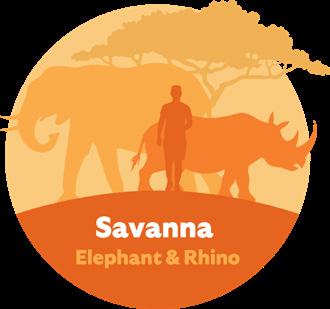


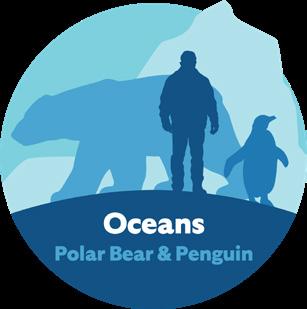

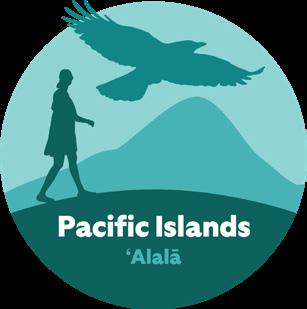


San Diego Zoo Wildlife Alliance protects and restores nature in eight Conservation Hubs on five continents. Below are recent discoveries and progress reports from around the world.

San Diego Zoo Wildlife Alliance and several Canadian partners, including Indigenous organizations, government agencies, and universities, are part of a project focused on evaluating sea ice ecosystem biodiversity in Canada’s southern Hudson Bay and James Bay. These evaluations center around areas that will hopefully be established as national marine conservation areas. This program is led by the Mushkegowuk Council, which represents the interests of seven local First Nations groups. San Diego Zoo Wildlife Alliance is the only non-Canadian organization to be invited into the project, reflecting the strength of our partnerships and our conservation expertise.

Our team and volunteers removed invasive species and sediment in and around two Western spadefoot conservation ponds in the Safari Park’s Biodiversity Reserve. Western spadefoots are native to California and northern Baja California, Mexico, but they have lost about 80% of their native range due to urban and agricultural development and are now proposed for listing under the Endangered Species Act. These toads depend on vernal ponds (pools that are filled by seasonal rains and disappear during dry seasons), like the two in the Biodiversity Reserve, to be able to breed and develop. Removing invasive plants and sediment will improve habitat quality and hopefully help the ponds retain water for longer. Last year 300 spadefoots morphed from our ponds, and we hope to grow on this success in 2025.

A rare fin whale cell line was recently added to San Diego Zoo Wildlife Alliance’s Frozen Zoo® Fin whales are the second-largest whale in the world (blue whales are the largest) and are therefore the second-largest mammals on Earth. These whales are endangered and elusive, but they can be spotted off the coast of San Diego in the late spring and summer. Using a sample sent to us by our partners at NOAA Fisheries, our team succeeded in establishing cells and banking them to preserve the precious genetic diversity they represent. This is only the second fin whale cell line in the Frozen Zoo and among very few fin whale cells banked in the United States.

Action Reaching Everyone) offers a unique opportunity to engage with nature. Partnering with San Pasqual Union school, this pre-K through 8th grade program provides wildlife-focused lessons aligned with state educational standards. Through hands-on learning, student-led discussions, and field trips to the San Diego Zoo and Safari Park, students learn about species and conservation actions relevant to their age. They explore both local and global conservation issues, empowering them to see how their choices impact the natural world.
One person who embodies the success of our educational programs is John Preciado, whose journey began visiting the Zoo as a child. At 13, he joined Zoo Corps, where he




learned about topics like endangered species and backyard conservation. The experience helped him develop public speaking skills and engage Zoo guests in meaningful conversations about wildlife. After his Zoo Corps journey ended near the end of high school, John returned to the Zoo, this time as a seasonal staff member, supporting summer camp as a program aide. Now, at 27, John works as an educator at the Zoo. In his role, John makes meaningful connections with guests and learners, sharing his love for wildlife and seeing the positive impact these interactions have on people. Watching individuals leave with a deeper understanding of conservation is the most rewarding part of his job.
John’s story illustrates the lasting impact of early conservation education. His path from a curious youth to a passionate educator highlights how our education programs can shape not only careers, but also futures. Through his work, he helps us fulfill our mission of inspiring conservation action. Our programs, like Conservation Corps and WE CARE, are more than just educational—they are empowering the next generation of conservation advocates. By fostering curiosity and empathy in young people, we are planting the seeds of hope for a future where wildlife and nature are valued and protected by all.
The Pacific pocket mouse once roamed an approximately 124-mile expanse of coastal Southern California, thriving in 30 documented localities during the 1930s. It played a vital ecological role, dispersing native seeds, aerating soil, and cycling nutrients within its habitat. However, urbanization and other human-driven activities caused devastating habitat loss, leading to widespread population declines, and by the mid-20th century, the species was thought to be extinct.
For two decades, the Pacific pocket mouse went undetected—until 1993, when it was rediscovered in a stroke of serendipity. Recognizing the urgency of its plight, it was emergency listed as endangered under the United States’ Endangered Species Act, sparking a collaborative effort to ensure its survival.
Today the species persists in just three small, isolated populations: in Dana Point, Santa Margarita, and South San Mateo. Habitat destruction, high fire frequency, invasive species, extended drought, and predation by nonnative animals have pushed the species to the brink, leaving fewer than approximately 90 breeding individuals across its remaining range. Low genetic diversity and inbreeding have further compounded the species’ plight. Genetic studies reveal a loss of diversity with the Dana Point population having roughly half of the diversity of mice in the 1990s. Inbreeding and low genetic diversity further threaten population persistence. These challenges underscore the urgency of the U.S. Fish and Wildlife Service’s recovery plan, which focuses on stabilizing and growing existing populations and establishing new ones to rebuild genetic diversity and resilience.
San Diego Zoo Wildlife Alliance’s Pacific Pocket Mouse Conservation Breeding and Reintroduction Program was launched in 2012 as an ambitious response to the crisis. Over the past decade, we have made remarkable strides, including developing specialized husbandry protocols and breeding techniques; learning about species behavior, ecology, physiology, and genetics to prepare mice for life in native habitats; and selecting, restoring, and managing reintroduction sites to ensure suitable habitat. These efforts have culminated in the release of over 500 conservation program-bred mice.
In 2016, the first reintroduced population was initiated at Laguna Coast Wilderness Park, where careful monitoring and research has provided invaluable insights into the factors that affect reintroduction success. This success set the stage for the program’s next challenge: establishing a second population.
In 2024, the program partnered with Marine Corps Base Camp Pendleton to release 90 Pacific pocket mice at Wire Mountain, a step that represents the largest single-year release in the program’s history. This site, carefully selected for its suitable habitat and strategic location within the mouse’s historical range, offers the species a fresh start.
The results have been exciting. By the end of the summer, our monitoring revealed high short-term survival, and most mice were reproducing. One hundred wild-born offspring—key indicators of reintroduction success—were documented at the site, marking a pivotal achievement in the species’ recovery journey.

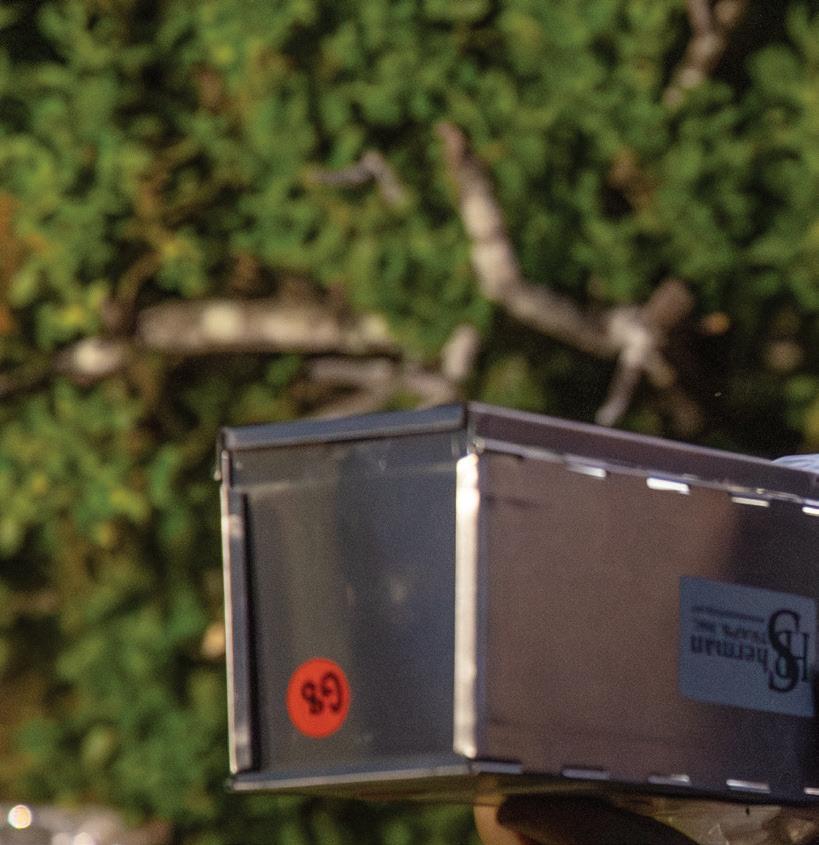




Couples looking for adventure, romance, and a one-of-a-kind wedding day can continue their love story at the San Diego Zoo and the San Diego Zoo Safari Park. From sweeping savanna views to lush green hideaways, we have the wild wedding venue of your dreams!




PH.D.
Henshaw Endowed Director of Reproductive Sciences
San Diego Zoo Wildlife Alliance
Barbara Durrant, Ph.D., leads research that covers biobanking, gametes, endocrinology, and physiology. Her team works to understand reproduction in a wide variety of animals—at levels ranging from species to tissues to cells, and down to genes and their expression—to enhance reproduction and genetic diversity in endangered species.
Reproductive science encompasses all the systems and pathways involved in producing healthy offspring. Because so many animal and plant species are currently experiencing threats to their survival, understanding reproductive processes is essential to their conservation. Our team concentrates on developing or improving assisted reproduction, including artificial insemination and in vitro embryo production; measuring hormones to monitor reproductive cycles and pregnancy; and preserving living cells in our Frozen Zoo® for future use in DNA studies and assisted reproduction.
From a very early age I was fascinated by animals. Growing up in upstate New York, our family lived, camped, and hiked in areas inhabited by moose, black bears, otters, frogs, turtles, and many more native species. We visited zoos or wildlife sanctuaries everywhere we traveled, and I loved learning about wildlife, boring my siblings with what I thought were fascinating facts. Learning about animal physiology, reproduction, and behavior as an undergrad solidified my intent to pursue a career in wildlife and conservation.
How does your team innovate solutions to reproductive science challenges?
When faced with a new challenge, we pore over the literature and contact scientists who are doing similar work, regardless of the species. Without exception, the scientists we’ve contacted have responded with enthusiasm for a chance to contribute to conservation science. We also draw on the expertise of our Wildlife Care and Wildlife Health teams for species-specific knowledge. Our team then discusses, decides what may be applicable, and designs protocols based on what we know of the species in question or related species with which we’ve had success. There’s also a healthy dose of intuition, or what geneticist Dr. Barbara McClintock’s biographer, Evelyn Fox Keller, described as “a feeling for the organism.”
Where do you find hope for the future of conservation?
In our institution and in the scientific community, we are surrounded by hope that our work will contribute to conservation initiatives that will save species. I see hope in the excitement of our guests at the San Diego Zoo and San Diego Zoo Safari Park, in the multidisciplinary collaborations throughout San Diego Zoo Wildlife Alliance, in the enthusiasm of our partners worldwide, in each birth that moves a species further from extinction, in my coworkers and teams, and in every successful study.
For sheer beauty and elegance, I favor the Somali wild ass. For companionship and mutual devotion—my dog.

From Aviary to Forest (Above) 'Alalā are cared for in aviary buildings like this one at two care facilities in Hawai'i. (Facing page, clockwise from top) 'Alalā are the last remaining corvid species endemic to Hawai'i. Author Brissa Christophersen enjoying the sight of ‘alalā in their forest home. 'Alalā typically lay about three eggs per clutch.
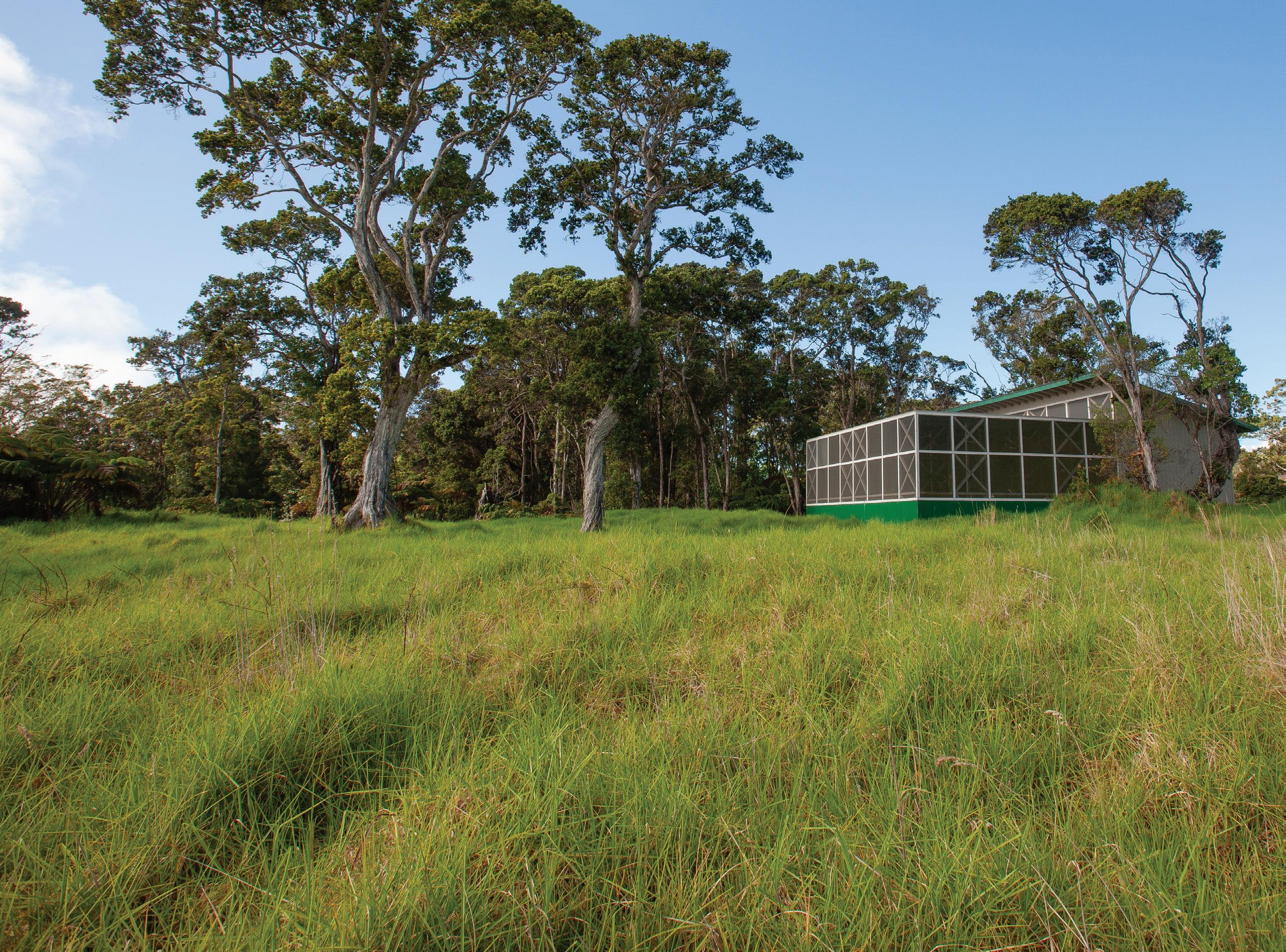
crow, plays a key role in a forest’s health. Once abundant across the landscape, the 'alalā population dwindled down to fewer than 20 individuals in the 1990s due to the aformentioned threats. As a result, 'alalā were brought into our care facilities in efforts to increase the population, yet the goal was always clear—to return them to their forest home, where they belong.
To revitalize 'alalā, it was not enough to simply care for them in our centers, the Keauhou Bird Conservation Center on Hawai'i Island and the Maui Bird Conservation Center on the slopes of Haleakalā. Our community had to address the root causes of their decline: habitat restoration, predator control, and the mitigation of disease. Over the years, many hands came together and this work paid off, and the population grew to over 140 individuals. Through collaborative efforts, the forests were restored and protected, and in 2016, a new chapter began.
Between 2016 and 2020, 30 'alalā were returned to their forest home on Hawai'i Island, where they could once again soar through the canopy, calling back and forth to one another from the treetops. They were finally among their family in the forest—back to the 'āina where they belonged. It was a moment of joy, of hope, of homecoming.
forward to today, and the hope for the 'alalā continues to grow. In November 2024, we were able to return five more 'alalā to their forest home on the island of Maui, a significant milestone in the ongoing effort to restore this iconic species. This return marks another step forward in ensuring the ʻalalā’s voices will once again fill the skies of Hawai'i, and that they will thrive in the forests that are their true home.
What does this process look like? Some people call it conservation breeding, or captive propagation. It may sound like a technical term, but this refers to producing offspring to increase the population from fewer than 20 'alalā to a peak of over 140. Some call it a sanctuary—a place of care and protection. We call it ho'iho'i, which translates as “to return, send back, or restore,” and represents what a joyous feeling it evokes.
For us, the work of conservation is about returning the 'alalā home to restore these familial ties to 'āina. Every step taken in the care facilities here in Hawai'i is purposeful, done with the intention of returning them home in a timely and righteous way. But this is not an easy task. It requires patience, attention to detail, and careful observation.
When we care for the 'alalā, we do not simply keep them in an enclosure or a sterile environment. We closely observe their behaviors


and needs. We learn what makes them feel comfortable, what makes them feel safe. 'Alalā are part of 'āina, and as a result, part of what feeds us and allows us as people to thrive. In turn, it’s our reciprocal responsibility to provide the utmost care to 'alalā, as we would to our extended family. To help ensure 'alalā are as comfortable as possible, we replicate their forest environment as closely as we can, with aviaries filled with the same native foliage to mimic the natural layers of the forest and curating optimal humidity and rain conditions.
Here we also ensure the infrastructure needed to care for them is in good working condition. The team monitors the birds for any signs of stress or potential health concerns. Every aspect of what we do is attended to with intention and care, so that when the time comes to return ʻalalā to their forest home, they are as ready as possible.

As we all know, the field of conservation is not easy, but it is essential. It is a labor of love, of hope, and of responsibility. The 'alalā are not just birds—they are interwoven threads that make up the fabric of Hawai'i lifeways. They are part of Hawai'i’s story, part of the rich cultural and ecological heritage that has shaped this land. And just as we care for our own, we care for them, so they can thrive once again.
This effort is not just about saving a bird—it is about saving a piece of ourselves, a piece of our home. When the 'alalā return to the forest, it is a reminder of what is possible when we work together. It’s a reminder that no matter how challenging the road may be, we can always return home, and that home will always be there, waiting for us.
In this way, we are not just conserving birds—we are building a better tomorrow for Hawai'i. A tomorrow where the land is filled with life, where the skies are once again filled with the songs of native birds, and where the land is cared for as it has been for generations. There is hope in this work, and hope for the future of the native species of Hawai'i. We are not just returning the 'alalā home—we are ensuring the land, the forests, and the animals who call it home can live and thrive, as they always should.
Brissa Christophersen is a research associate and Bryce Masuda is a senior conservation program manager with San Diego Zoo Wildlife Alliance’s Conservation Science Wildlife Health team.



cryopreservation. Through micropropagation we can grow living oak tissue in the lab and hold a grove of endangered trees in the palm of our hand. And with cryopreservation, the same technology that supports San Diego Zoo Wildlife Alliance’s Frozen Zoo® now can also be applied to plants. As this research moves forward, it will help preserve genetic material for generations of conservation work to come.
Del Mar and La Jolla, California, are famous for their stunning beaches and the iconic Torrey pines that tower above the rugged sandstone bluffs. These majestic trees are the rarest pine species in North America, found only along the central coast of San Diego County and on Santa Rosa Island, 173 miles off Santa Barbara. Sadly, drought and bark beetle outbreaks are threatening the last native Torrey pines on mainland California, and challenges to environmental sustainability are only making things worse.
For decades, the Zoo and Safari Park have been leaders in Torrey pine conservation. Our team has been carefully growing and studying Torrey pines to support ongoing conservation efforts. For over 50 years, our horticulturists and arborists have honed their skills to help these trees thrive from seed to maturity. Safari Park arborists, working alongside Plant Conservation scientists, collect germplasm samples from Torrey Pines State Natural Reserve, contributing to vital genetic research. By studying both the ex situ trees at the Safari Park and native Torreys, we’re working to understand how to protect and manage Torrey pines. This research will help ensure the long-term survival of this unique species.

Growth Potential
(Pages 22 and 23) The majestic fevertree at the Safari Park’s reclamation pond. (Inset) Fevertree cone. (Page 24) Torrey pine. (Inset) Torrey pine cone. (Page 25) San Diego Zoo horticulturists Dario Berrini and Greg Bluffin collect acorns for propagation. (Inset) Eastern Cape giant cycad cone.


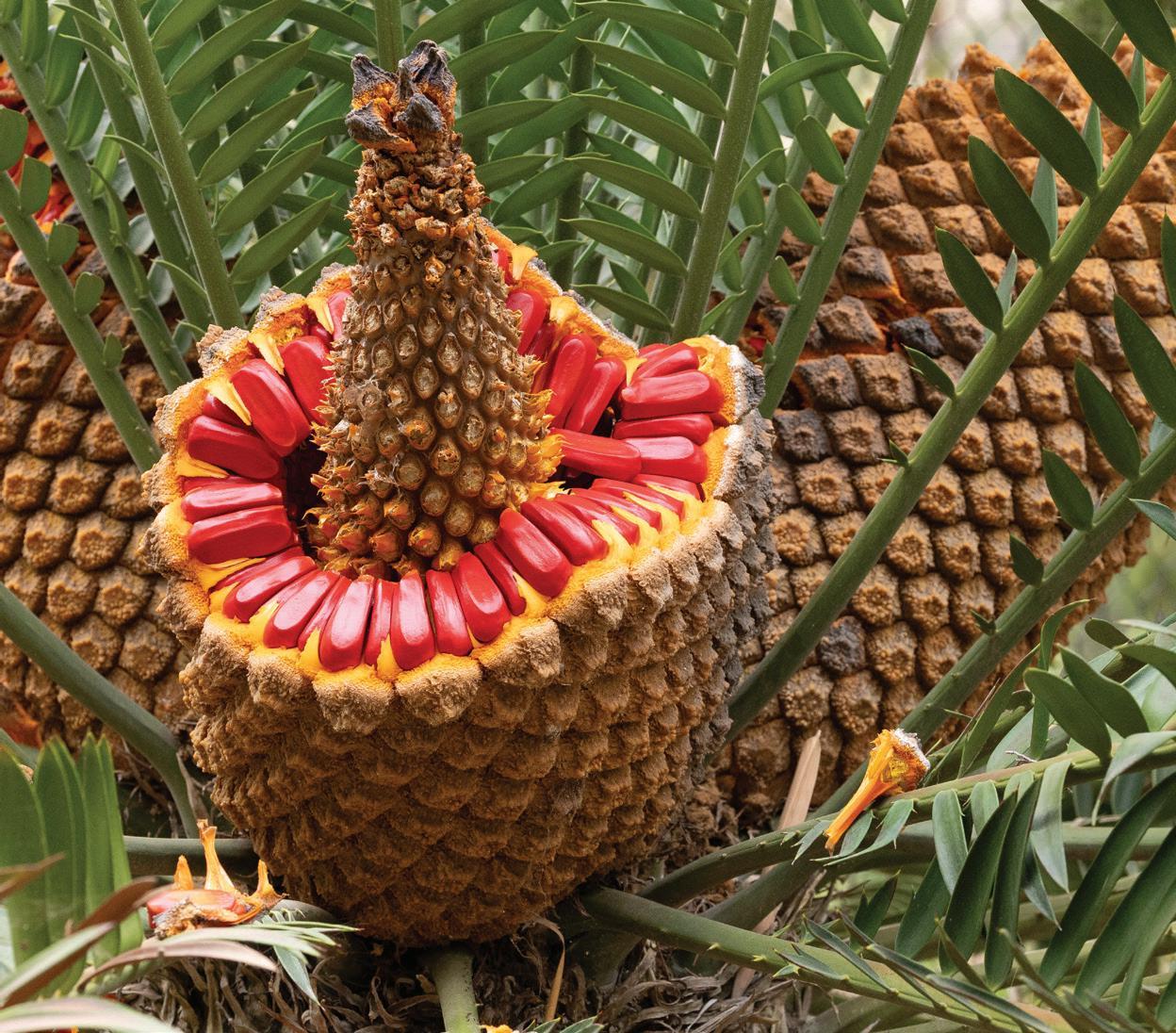
Cycads are some of the planet’s oldest survivors—ancient seed plants that have stood the test of time, outliving the dinosaurs and surviving three mass extinctions over millions of years. But today these remarkable plants face an uncertain future. Caught in the crosshairs of wildlife trafficking, habitat loss, and challenges to environmental sustainability, many cycad species are now among the most threatened plants on Earth, with some teetering on the edge of extinction due to human impact.
San Diego Zoo Wildlife Alliance is stepping up to protect these living fossils. With extensive cycad collections at both the Zoo and Safari Park, we’re using our horticultural expertise and global partnerships to ensure the survival of these ancient plants. As part of the
Global Conservation Consortium for Cycads, San Diego Zoo Wildlife Alliance is leading efforts to save cycad species from disappearing forever. One exciting development is our newly created Cycad Species Stewardship Garden at the Safari Park, which focuses on South Africa’s rare Encephalartos species. Located along the Africa Tram, this garden not only showcases these incredible plants, but also supports critical propagation efforts and offers a chance to share the story of cycad conservation with visitors.
We’re also funding research on native cycad populations in South Africa, collaborating with organizations like Botanic Gardens Conservation International and the Wild Cycad Conservancy. Together, our goal is clear: ensure that no wild cycad species becomes extinct. Through education, conservation, and collaboration, San Diego Zoo Wildlife Alliance is helping secure a future for these ancient plants that have already defied the odds for millions of years.
This is just the beginning of our tree and plant conservation efforts! Through projects like the Native Seed Bank at the Safari Park and our work in places like Palau, Hawai'i, South Africa, and beyond, we’re making a real difference in protecting trees and plants worldwide. If you’d like to know more about all our plant conservation efforts, please consider visiting the Zoo during the third Friday of every month for our Plant Day event. The Safari Park now offers a Botanical Tram tour on Saturdays and Sundays at noon, where guests can enjoy a unique, plant-focused tour that highlights plant conservation and zoological horticulture. The seeds we plant today—both horticultural and educational— will help propagate a brighter future for all.
Raj Brown is director of horticulture for the San Diego Zoo Safari Park. Adam Graves is director of horticulture for the San Diego Zoo.
Every visit to the San Diego Zoo’s Denny Sanford Wildlife Explorers Basecamp is an adventure. There’s so much to see and do. But before you head to Basecamp’s four nature play areas—Desert Dunes, Wild Woods, Marsh Meadows, and Rainforest— let’s make sure you have everything you need for a day full of fun and adventure.
A hat will help protect your face from the sun as you climb, splash, play, and visit wildlife.
A backpack can keep all your gear organized and ready to use.
Sunburns are no fun. Remember to put on sunscreen more than once.
A San Diego Zoo map can guide you through Basecamp—you don’t want to miss anything!
Keep your water bottle filled and ready. Thirst can sneak up on you.
After a splash session in the water play area, a towel can come in handy to dry off.
Binoculars can give you an up-close look at wildlife throughout Basecamp, whether you want to peer at prairie dogs, look at
ants, or check out
Write down a few questions you may have for our wildlife care specialists about the species in Wildlife Explorers Basecamp. They will be happy to answer them!
Visit the San Diego Zoo Wildlife Explorers website to find out about these and other animals, plus videos, crafts, stories, games, and more!
SDZWildlifeExplorers.org
Let’s go! Don’t forget the most important thing you can take with you on your visit: a sense of wonder! Be ready to enjoy all the amazing experiences that await in Wildlife Explorers Basecamp.